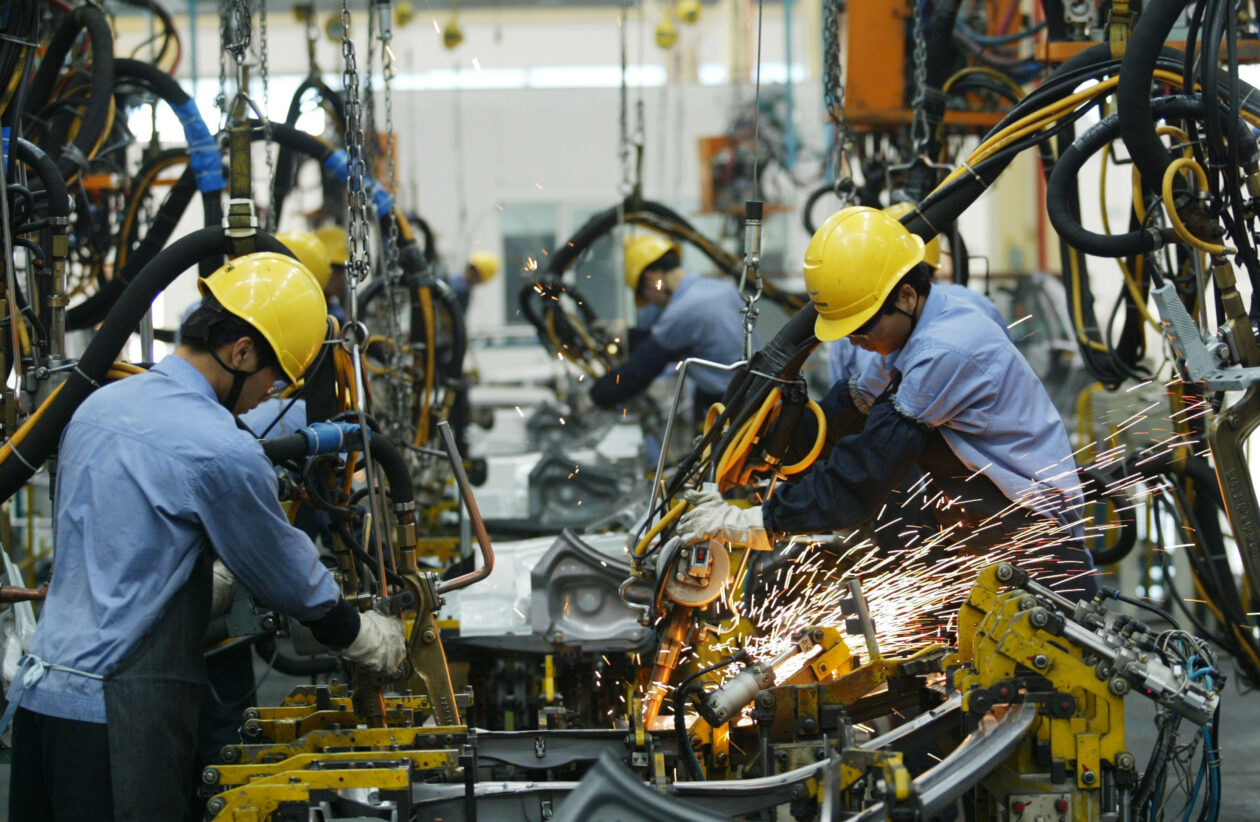Last month, Beijing launched China’s first metaverse patent pool, allowing enterprises and academic institutions to cross-license technologies related to the emerging sector.
The project – part of the capital’s ambition to attract more than 100 metaverse enterprises by the end of 2024 – includes about 170 metaverse-related patents so far. But Beijing is one of many Chinese cities that aims to become a hub of digital world technologies.
In October last year, the Ministry of Industry and Information Technology issued a three-year plan for China’s “industrial metaverse” making the technology part of a national strategy to build a digital economy that complements its current economy, which at US$18 trillion is second only to the U.S.

China’s interest in the metaverse primarily lies in its benefits to real-world industries, said Deng Jian-peng, a fintech law specialist and law professor at the Central University of Finance and Economics in Beijing.
“An example (of metaverse’s usage in legacy industries) could be BMW’s industrial metaverse built by [Artificial Intelligence leader] Nvidia, which provides a digital replica of BMW’s production line so that the automobile maker can test and optimize its performance at lower costs,” said Deng.
Metaverse with China characteristics
Earlier in January, China’s financial capital Shanghai unveiled 20 metaverse use cases it plans to develop by the end of 2025. They range from a virtual replica of a state-owned steel plant to a metaverse hospital for patients to receive remote diagnosis.
Illustrating the government’s focus, not a single use case seeks to build open metaverse games, such as Decentraland and Sandbox.
Zhao Xing, a professor at the Institute of Big Data at Shanghai’s Fudan University, reiterated the point that China’s metaverse projects focus on real-world scenarios.
“Fundamentally, China aims to use the metaverse to solve the issues in the existing technologies, industries and administrations,” Zhao said.
“After missing the [earlier] opportunities in the internet, mobile web and artificial intelligence, China’s regional governments are striving for leadership in the metaverse, which is still at its early stage and undetermined.”
On the corporate side, “the adoption of the metaverse in real-world use cases may grant legacy industries an opportunity to incubate innovations at the front of information technologies,” said Zhao. He cited the metaverse collaboration between major Chinese liquor company Kweichow Moutai and tech giant NetEase that launched a winery-themed metaverse and issued NFTs linked to liquor bottles.

China’s restrictions on cryptocurrencies and NFTs are another factor driving the focus on the industrial metaverse, according to Deng.
“Open metaverses like Sandbox usually include cryptocurrencies as an incentivization. For example, Sandbox issues SAND, which users acquire to purchase NFTs. Then there will be trading, investments, speculations and potential money laundering in this ecosystem, but metaverse platforms might not meet the standards of financial regulators,” he said.
Deng noted that cryptocurrencies and NFTs are vital to verify ownership and facilitate transactions in open metaverses, which might be a future trend in metaverse technologies. However, the compliance issue outweighs the opportunity.
“This (involvement of cryptocurrencies and NFTs) raises legal risks, and can be a policy-sensitive topic in China,” said Deng.
No crypto
The financialization of digital assets is a hot-button issue for China’s regulators, who outlawed initial coin offerings (ICO) of cryptocurrencies as early as 2017 and then issued a blanket ban on cryptocurrency trading in September 2021.
As a result, policy makers have shunned public blockchains like Ethereum and Solana for private or permissioned networks without cryptocurrencies, where access is controlled by a single or several identified entities.
“China’s government favors a blockchain ecosystem without cryptocurrencies, making public blockchains hard to promote,” said Deng. “Meanwhile, private or permissioned blockchains are controlled by one big company or several centralized nodes, which are easier to supervise for regulators.”
However, China’s crypto regulations might be open for revisions in the future, especially since Hong Kong introduced new rules for trading cryptocurrencies on June 1.
”It’s like what we did with Shenzhen in the Chinese Economic Reform in the 1980s,” said Deng. “We can evaluate the risks in crypto assets through the experiments in Hong Kong, and then decide whether or how to adjust the crypto regulation in the mainland, which I think should definitely be open for consideration.”

And public blockchains are still within the scope of China’s policy makers. On June 13, the government of Shanghai released a three-year plan for technical research in the blockchain industry, which includes support for developer tools for both consortium blockchains and “mainstream public blockchains,” and to improve the interoperability between differently structured blockchain networks.
Metaverse hype
While China aims to set a national metaverse strategy, that hasn’t stopped the hype around the potential of the technology across the country and the FOMO (fear of missing out), with more than a dozen Chinese provinces and cities rolling out metaverse plans and policies.
Regardless of different economic conditions, regional governments seem to boast the same ambitions: “Introducing at least 100 metaverse companies” or “building at least 30 exemplary metaverse use cases.”
These statements repeat in metaverse plans, whether they are the country’s massive metropolises, such as Beijing and Shanghai, or less prominent ones like Jinan and Zhengzhou.
Rivalry among Chinese government officials plays a role in the metaverse hype, said Deng, as careers rely on a jurisdiction’s economic performance. The more revenue generated by local enterprises, the more likely local policy makers will receive a promotion.

Some cities are dangling cash. Zhengzhou City, which issued its metaverse plan relatively late on May 24, offers a startup capital investment of up to 200 million yuan (US$28.34 million) to metaverse companies that move their headquarters to the city.
“It might be bad for the industry if so many regional governments rush out metaverse policies,” said Deng.
“It would be better to develop technologies first in tier-one cities such as Beijing, Shanghai, Guangzhou, Shenzhou and Hangzhou, and then use these cities as examples to expand the metaverse adoption in other regions,” he said.
Challenges
Despite the governments’ ambition, some of China’s biggest technology companies are seemingly winding down their metaverse businesses.
In February 2023, Tencent, which runs China’s top social media Wechat, ran what it called a “personal reshuffle” in its 300-person extended reality unit that handles metaverse initiatives, which local media said was a disbanding of the division.
These developments took place as U.S. corporations such as Meta cut jobs and reported billions of dollars in losses at its metaverse operations. Disney also scrapped its metaverse plans.
Baidu, the Chinese technology giant known as the country’s equivalent of Google, also appears to be losing its interest in the metaverse.
In May, Majie, the project manager of Baidu’s Xi-rang metaverse, reportedly left the company, citing poor profitability and the company switching its focus to artificial intelligence. Baidu has not replied to Forkast.News request for comment.
“Building an immersive metaverse has great demands for hardware, software and research talents,” Deng said.
“The metaverse experience built by the above corporations (Tencent and Baidu) are still far from users’ expectations. And Apple’s recent virtual reality headset release indicates that the U.S. companies are still leading the global metaverse developments.”

China’s metaverse developments face other challenges.
“Metaverse relies on high-performance computer CPUs, which are primarily produced by U.S. corporations such as Nvidia,” said Deng.
With the U.S. controlling the global chip supply and the persistent tension between the U.S. and China, “it might be challenging to acquire enough qualified CPUs to satisfy the computing power demands from the metaverse industry.”
Elsewhere, Japan and South Korea are also investing heavily in metaverses and their friendlier business environments and regulations might give them an edge, while China enjoys the advantage of user base and funding, said Deng.
“In terms of promoting metaverse adoption with the might of capital, China is definitely the most likely to succeed.”
According to Zhao from Fudan University, the three countries’ metaverse initiatives represent different aspects of the metaverse, which could all contribute to the future of this emerging industry.
“South Korea’s metaverse roadmap is closer to the ‘virtual space’ route advocated by the likes of [Mark Zuckerberg’s] Meta, while Japan focuses on Web 3.0 and digital assets,” said Zhao from Fudan University.
“The routes taken by the three countries have their own features, and I wish to see the three routes merge in 20 years when we finalize the definition of the metaverse.”





